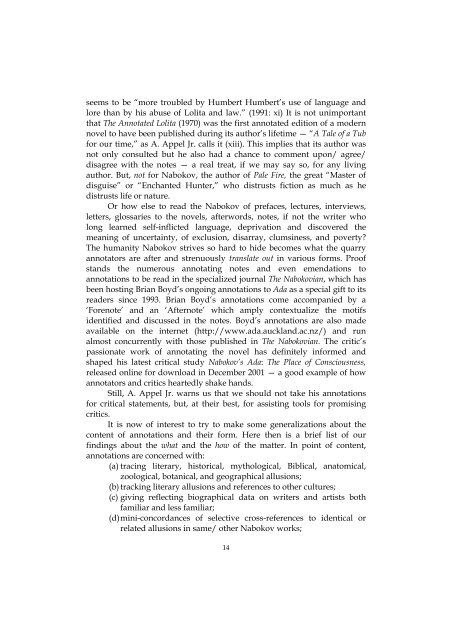translation studies. retrospective and prospective views
translation studies. retrospective and prospective views
translation studies. retrospective and prospective views
Create successful ePaper yourself
Turn your PDF publications into a flip-book with our unique Google optimized e-Paper software.
seems to be “more troubled by Humbert Humbert’s use of language <strong>and</strong><br />
lore than by his abuse of Lolita <strong>and</strong> law.” (1991: xi) It is not unimportant<br />
that The Annotated Lolita (1970) was the first annotated edition of a modern<br />
novel to have been published during its author’s lifetime — “A Tale of a Tub<br />
for our time,” as A. Appel Jr. calls it (xiii). This implies that its author was<br />
not only consulted but he also had a chance to comment upon/ agree/<br />
disagree with the notes — a real treat, if we may say so, for any living<br />
author. But, not for Nabokov, the author of Pale Fire, the great “Master of<br />
disguise” or “Enchanted Hunter,” who distrusts fiction as much as he<br />
distrusts life or nature.<br />
Or how else to read the Nabokov of prefaces, lectures, inter<strong>views</strong>,<br />
letters, glossaries to the novels, afterwords, notes, if not the writer who<br />
long learned self-inflicted language, deprivation <strong>and</strong> discovered the<br />
meaning of uncertainty, of exclusion, disarray, clumsiness, <strong>and</strong> poverty?<br />
The humanity Nabokov strives so hard to hide becomes what the quarry<br />
annotators are after <strong>and</strong> strenuously translate out in various forms. Proof<br />
st<strong>and</strong>s the numerous annotating notes <strong>and</strong> even emendations to<br />
annotations to be read in the specialized journal The Nabokovian, which has<br />
been hosting Brian Boyd’s ongoing annotations to Ada as a special gift to its<br />
readers since 1993. Brian Boyd’s annotations come accompanied by a<br />
‘Forenote’ <strong>and</strong> an ‘Afternote’ which amply contextualize the motifs<br />
identified <strong>and</strong> discussed in the notes. Boyd’s annotations are also made<br />
available on the internet (http://www.ada.auckl<strong>and</strong>.ac.nz/) <strong>and</strong> run<br />
almost concurrently with those published in The Nabokovian. The critic’s<br />
passionate work of annotating the novel has definitely informed <strong>and</strong><br />
shaped his latest critical study Nabokov’s Ada: The Place of Consciousness,<br />
released online for download in December 2001 — a good example of how<br />
annotators <strong>and</strong> critics heartedly shake h<strong>and</strong>s.<br />
Still, A. Appel Jr. warns us that we should not take his annotations<br />
for critical statements, but, at their best, for assisting tools for promising<br />
critics.<br />
It is now of interest to try to make some generalizations about the<br />
content of annotations <strong>and</strong> their form. Here then is a brief list of our<br />
findings about the what <strong>and</strong> the how of the matter. In point of content,<br />
annotations are concerned with:<br />
(a) tracing literary, historical, mythological, Biblical, anatomical,<br />
zoological, botanical, <strong>and</strong> geographical allusions;<br />
(b) tracking literary allusions <strong>and</strong> references to other cultures;<br />
(c) giving reflecting biographical data on writers <strong>and</strong> artists both<br />
familiar <strong>and</strong> less familiar;<br />
(d) mini-concordances of selective cross-references to identical or<br />
related allusions in same/ other Nabokov works;<br />
14












